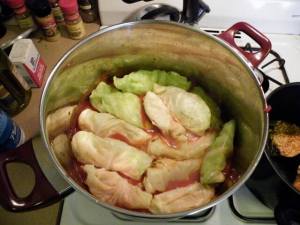Ah, the humble cabbage. This cruciferous vegetable has been at the heart of many diets, and for good reason. Just half a cup can deliver a third of your daily Vitamin C requirements, as well as healthy servings of fiber, potassium, magnesium, Vitamins A and K and folate. It can be boiled, baked, shredded and eaten raw, and even fermented. Cabbage is one of the most versatile vegetables known to man. It also tastes good, which is always a bonus.

(Photo by gran/CC BY-SA 2.0)
When I was a child, Mom often made stuffed cabbage for dinner. We always knew when she was making it, because the pressure cooker came down from the top of the closet. It was a dish that was usually saved for winter dinners, which was delightful because the aroma in the air seemed to almost warm up the house on cold nights.
It seemed to be a process, one which I have never mastered in my adult life. Mom undertook the task with painstaking care as she slowly peeled leaf after leaf from the cabbage head. Beside her, a bowl full of ground beef that had been seasoned with assorted spices patiently awaited formation into meat patties. The patties were wrapped in a leaf and held together with toothpicks. When the entire bottom of the pressure cooker had been filled with little green cabbage “pillows”, Mom placed the lid on the pot and let the pot work its magic. While never a fan of stuffed peppers as a child, I was always the first to clean my plate when Mom made stuffed cabbage.
Dad enjoyed a sweet and sour red cabbage that was made with applesauce and could be found in the condiment section of the now defunct Grand Union. The brand name eludes me, though I believe it began with “L.” The “Aunt Nellie’s” brand appears closest to the label style I remember. Dad and I easily polished off a jar by ourselves, since my sister held her nose when we opened it and Mom seemed to be of the same mind. Though most brands serve the dish warm, Dad and I enjoyed it straight from the jar. Mom always used to say, “You’ll get botulism!” Dad quipped that the stink of the cabbage probably killed the bacteria off.
When I met my husband, I found that his family often enjoyed cabbage in a can, better known as sauerkraut. The dish made most often at his home, which is technically known as “Croatian Sauerkraut,” was a delicious amalgamation of tomato sauce, bacon fat, canned sauerkraut, garlic and onions. My mother-in-law often served the dish with roast beef, though my husband’s grandmother only served it with pork. I could easily sit down to a dinner of the sauerkraut alone and often helped myself to seconds. When I was working in homecare, one of my co-workers remarked that her family used caraway seeds and omitted the sauce. I tried it once and decided that I liked the Croatian recipe much better. Grandma Nettie, my husband’s grandmother, also made a cabbage soup with beef cubes and a can of tomato sauce that would knock anything that ailed you right out of your system. It was deliciousness in a bowl.
Hubby and I watched a lot of cooking shows throughout our years together. One of our favorite shows was The Frugal Gourmet with Jeff L. Smith. During one episode on PBS, Jeff created “Peasant Dish,” which was sliced cabbage that had been sautéed with garlic and onions. It quickly became a family favorite and my daughter often requested it for dinner in her youth. As I write this, a pot of red cabbage sits in my large Dutch oven and anxiously awaits its transformation into “Peasant Dish.” For the record, this recipe closely resembles the British “Bubble and Squeak” but omits the potatoes.

(Photo courtesy of Korea.net/Korean Culture and Information Service/CC BY-SA 2.0)
While I have been aware of its presence, I never tried kimchi, which is a Korean side dish of fermented, salty vegetables like napa cabbage, carrots, garlic, ginger and radish. To be honest, it looked a little scary in the jar on Target’s shelf, but I figured I would give it a whirl. I was so pleasantly surprised with its flavor that I finished half the jar in one sitting. I look forward to my next visit to the superstore to purchase more kimchi.
Aside from previously mentioned benefits of the crunchy vegetable, cabbage juice can help heal stomach ulcers. Red cabbage in particular helps raise levels of lutein, which can reduce the progression of age-related macular degeneration by about 20 to 25 percent. Red cabbage can also help to reduce inflammation and is known to have some cell-protective effects as well. The next time you peruse the produce aisle at ShopRite, Stop and Shop or even Target, pick up a head of the crunchy vegetable and create your own delicious meal. You can find the pre-shredded variety as well, especially good for those unable to wield a large knife. In time, you may realize the many benefits of cabbage, the cruciferous champion of diets worldwide.
Patty Servidio is an Anton Media Group columnist.





























